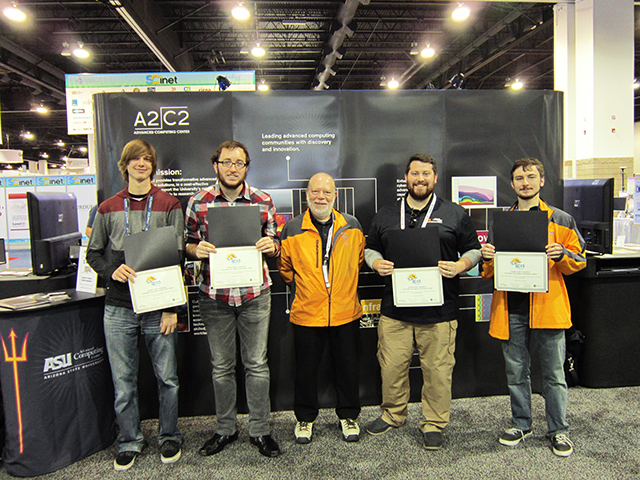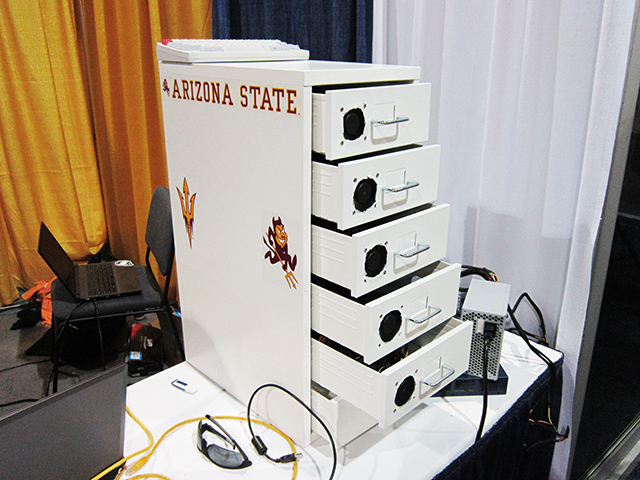
ASU students bring home award from international supercomputing competition

The ASU team won an award at the recent Supercomputing 2013 (SC13) Student Cluster Challenge. Pictured from left to right are team members Gabe Martin, Christian Ivaneok, mentor Charlie Collins, Clint Shuman and Ben Prather. Photo by: Marisa Brazil
A team of ASU undergraduate students brought home a first-place award from the Supercomputing 2013 (SC13) Student Cluster Competition held November 20-21, 2013 in Denver. The competition required students to work nearly non-stop over a 48-hour period to assemble and test a small computing cluster – a group of tethered computers that can perform a series of applications.
The team included juniors Clint Shuman, a computer science major, Gabe Martin a computer systems engineering student, Ben Prather a physics major, and Christian Ivaneok an informatics major.
The students competed against three teams in the Commodity Cluster track, which limits the students to a budget of $2,500 and a strict energy draw limit of 15 amps. Prior to the competition, the students worked with mentors from ASU’s Advanced Computing Center (A2C2) to build the cluster, using affordable and commercially available components. A2C2 was the ASU team’s sponsor. Support for the team was also provided by the School for Computing, Informatics, and Decision Systems Engineering.
“The team’s goal was to have all of the hardware selected and set up so that all we had to do at the competition was power it up, do some fine-tuning, submit it different tasks, and watch the machine successfully complete each challenge,” says Frank Timmes, a team mentor and the director of A2C2.
Teams raced to complete the most software applications in front of an audience and other competitors. For one task students were given the data set for Weather Research Forecasting software to run on their cluster. They were instructed to set it up and simulate the monitoring of Hurricane Sandy. After working through a variety of tasks, each team was interviewed by a team of judges who tested their knowledge of the diverse applications.
In the Commodity Cluster track, the ASU team won an award for the Lowest Dollars-per-gigaFLOPS by spending just $4.96 per gigaFLOPS. FLOP refers to “floating point operations.” In simple terms, the ASU team was able to do the most cluster operations per dollar spent.
“Using minimal energy is important because it generates less heat, and less heat means less money has to be spent on an advanced cooling system,” says team member Ivaneok. The Commodity Cluster track included a “green computing” goal which the ASU team’s cluster was able to meet by performing the most gigaFLOPS (per dollar) per watt of energy.
Ivaneok says the team chose to pursue the Commodity Cluster track challenge because they didn’t want to rely too heavily on industry sponsors to provide good equipment. “We liked the challenge of doing it with limited means,” says Martin.
An additional challenge for the ASU team was competing with only four team members while other teams had five. Ivaneok says he is proud of their ability to bring home a first-place award despite this disadvantage.

Pictured is the team’s small computing cluster built for the competition. A cluster is a group of tethered computers that can perform a series of applications. Photo by: Marisa Brazil
Both Ivaneok and Martin describe the competition as a lot of fun. “We’re all a bunch of geeks and we had a lot of fun getting to know the other teams. There wasn’t anything cutthroat about the competition,” says Ivaneok.
Most team members got involved because of their interest in the technical aspects of learning to build a cluster. But in the end, they say they’re glad they entered the competition because of the time spent together and the networking opportunities.
“It was especially motivating to meet industry workers that got their start at the same competition five years earlier,” says Ivaneok.
“The competition taught me a lot about networking and social skills,” adds Martin.
The ASU team was mentored by Timmes and other A2C2 staff members, including Charlie Collins, the operations manager, Mohamed Sayeed, applications specialist, and Marisa Brazil, the senior coordinator of projects and programs.
“We wanted to mentor this team because we believe in the fantastic educational and career enhancing opportunities this provided for the students,” says Timmes. “The opportunity will give them a deeper understanding of the technology used in much of 21st century science and engineering,” he adds.
Ivaneok says, “I speak on behalf of all of us in expressing our appreciation for the mentorship that the A2C2 mentors provided us. Honestly, working with them and my teammates in this competition is one of the best things I’ve ever done. It’s even up there with hockey and off-roading.”
The team hopes to obtain the sponsorship they will need to compete again next year.
The Student Cluster Competition was part of the annual Supercomputing Conference (SC13) sponsored by the Association for Computing Machinery and the Institute of Electrical and Electronics Engineers Computer Society. The conference offers a complete technical education program and an exhibition to showcase the many ways high-performance computing, networking, storage and analysis lead to advances in scientific discovery, research, education and commerce.
Written by Rosie Gochnour
Media Contact:
Joe Kullman, [email protected]
(480) 965-8122
Ira A. Fulton Schools of Engineering



































